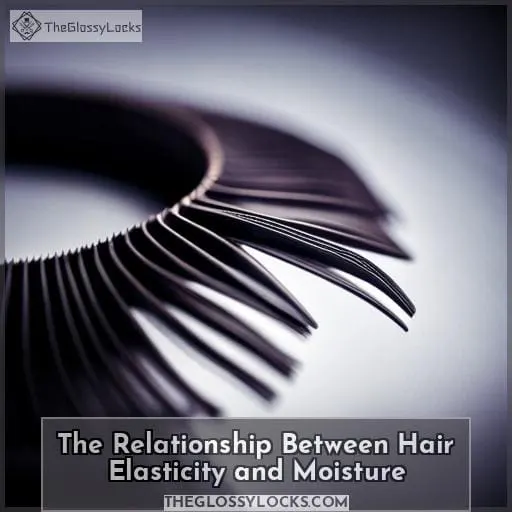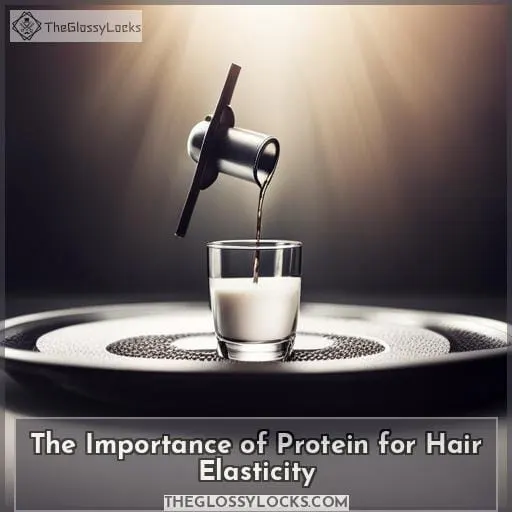This site is supported by our readers. We may earn a commission, at no cost to you, if you purchase through links.
 Ready to uncover the truth behind why your hair is elastic? It’s time to investigate the causes and find solutions for this common issue.
Ready to uncover the truth behind why your hair is elastic? It’s time to investigate the causes and find solutions for this common issue.
Discover how moisture levels affect hair elasticity, learn simple tests you can do at home, and explore the importance of protein in maintaining healthy strands. With expert tips and advice, you’ll be equipped with all the knowledge needed to improve your hair’s elasticity and achieve strong, resilient locks.
Let’s dive in!
Table Of Contents
- Key Takeaways
- What Does Stretchy Hair Indicate?
- The Relationship Between Hair Elasticity and Moisture
- How to Test Hair Elasticity
- The Importance of Protein for Hair Elasticity
- Tips to Improve Hair Elasticity
- Common Causes of Hair Elasticity Issues
- How to Restore Hair Elasticity
- Frequently Asked Questions (FAQs)
- What are some signs my hair elasticity is imbalanced besides stretchiness?
- Does hair dye or other chemical treatments affect elasticity?
- Can certain medications or health conditions lead to elasticity issues?
- Is hair elasticity genetic or can it change as I age?
- Are there any home remedies to help with elasticity besides deep conditioning?
- Conclusion
Key Takeaways
- Stretchy hair can be caused by overprocessing, lack of proper care, and overuse of heat styling tools.
- Hair that lacks moisture and elasticity is prone to breakage and frizz.
- Improving hair elasticity can be achieved by using moisturizing products, limiting heat styling, incorporating protein treatments, and getting regular trims.
- Protein is essential for maintaining hair strength, structure, and moisture retention.
What Does Stretchy Hair Indicate?
Stretchy hair indicates that your strands may be lacking in health and strength.
When your hair is stretchy, it means that the structure of your hair is compromised, leading to a decrease in its ability to retain moisture and withstand damage.
There can be various causes for stretchy hair, including overprocessing and chemical treatments, lack of proper care, and overuse of heat styling tools.
To address this issue, there are several remedies available.
Using moisturizing shampoos and conditioners can help restore hydration to the hair.
Additionally, incorporating deep conditioning treatments once or twice a week can provide much-needed nourishment.
It’s also important to limit heat styling as excessive use can further damage the elasticity of the hair.
There are products specifically designed to improve elasticity levels such as protein treatments which help strengthen damaged strands.
Prevention plays an essential role in maintaining healthy elastic locks; avoiding harsh chemicals or using protective measures while undergoing chemical processes will prevent further damage.
In conclusion, hair elasticity reflects how well our tresses maintain their shape when stretched – too little flexibility signifies weakened fibers due either from excessive manipulation or insufficient maintenance practices.
However by following these tips you’ll begin on a journey towards healthier-looking locks with improved strength ,shine,and decreased breakage.
The Relationship Between Hair Elasticity and Moisture
To understand the relationship between hair elasticity and moisture, it’s important to recognize that proper hydration plays a key role in maintaining the strength and flexibility of your strands.
Hair that lacks moisture tends to have low elasticity, which can lead to breakage and frizz. On the other hand, well-moisturized hair has higher elasticity, allowing it to stretch without snapping.
When your hair lacks moisture, it becomes dry and brittle. This causes the cuticles on each strand of hair to lift up, making them more susceptible to damage from heat styling tools or chemical treatments.
Additionally, lack of moisture can affect your hair’s texture by causing it to become rough or coarse.
Protein also plays an essential role in maintaining healthy levels of elasticity in your locks. Protein helps strengthen the structure of individual strands by filling any gaps or weak areas along their length.
To improve both protein levels and moisture content in your tresses:
- Use moisturizing shampoos and conditioners.
- Beware excessive use hot styling tools.
- Incorporate regular deep conditioning treatments into your routine.
- Be mindful about protecting against UV rays & wind exposure
- Limit chemical treatments such as bleaching or perming
By ensuring adequate hydration for your tresses through these methods, you’ll be able maintain optimal levels of hair elasticity and enjoy stronger, strands less prone to breakage.
How to Test Hair Elasticity
To test your hair’s elasticity, first wet your hair.
Next, separate a small strand and stretch it to observe how far it extends before breaking.
Finally, assess the results to determine if your hair’s elasticity is low, balanced, or high.
Step 1: Wet Your Hair
When testing hair elasticity, start by wetting your hair.
Fully saturate a few strands, but not to the point they feel slippery.
Observe how the wet hair stretches and responds when gently pulled.
Wet hair should have some natural give without feeling overly mushy.
If hair snaps right away or stretches significantly with little recoil, elasticity may be compromised from lack of moisture or protein.
Healthy hair with good elasticity will stretch slightly then bounce back.
Step 2: Separate a Small Strand
Separate a small strand of wet hair for testing its elasticity.
Hold it firmly between your fingers, then pull it slowly to stretch it out.
Watch it bounce back or not.
This test shows whether your hair needs more moisture or protein to regain elasticity.
Key indicators are overprocessed, heat damaged, or lifeless hair.
Step 3: Stretch and Observe
Now, take the strand you separated and gently stretch it out to test its elasticity.
Pay attention to how much the hair stretches before it breaks or returns to its natural shape.
Elasticity is important for strong, healthy hair that can withstand pressure without breaking.
Step 4: Assess the Results
You should now assess how far you could stretch your hair before it broke or regained its shape to determine the level of elasticity.
Testing your hair’s elasticity will provide valuable information about its health and condition.
You can use a hair elasticity test at home to measure the results.
A chart or scale can help interpret the test results, and there are also video tutorials available for guidance.
The Importance of Protein for Hair Elasticity
A delicate balance of protein is vital for your hair’s elasticity.
Protein plays a crucial role in maintaining the strength and structure of your hair strands. It helps to rebuild damaged areas, improve moisture retention, and enhance overall hair health.
When there’s a deficiency of protein in your hair, it can lead to decreased elasticity. This means that your hair will be more prone to breakage and may feel limp or lack bounce. To restore optimal levels of protein, you can incorporate rebuilding treatments into your routine.
Protein-rich foods such as eggs, lean meats, fish, beans, and nuts are also beneficial for promoting healthy hair growth from within. Additionally, using shampoos that contain high amounts of proteins can help replenish lost nutrients directly onto the strands.
Maintaining a proper moisture balance along with adequate protein intake is key in achieving optimal elasticity for your locks.
Provide regular nourishment through deep conditioning treatments containing proteins like keratin or collagen which repair damage while improving flexibility.
Additionally, you should limit heat styling tools as excessive heat exposure weakens structural integrity.
Avoid chemical processes too frequently since they strip natural oils exacerbating dryness.
Ending with regular trims gets rid off split ends preventing further damage.
Having knowledge about these factors will empower you towards making informed decisions regarding proper care- resulting ultimately in healthier, happier tresses!
Tips to Improve Hair Elasticity
You can take some simple steps to help improve your hair’s elasticity.
Use moisturizing shampoos and conditioners.
Limit heat styling tools.
Incorporate protein treatments into your hair care routine.
These methods can help restore moisture and protein balance to your hair over time.
Use Moisturizing Hair Products
After boosting hair elasticity with protein treatments, moisturize your locks by using shampoos, conditioners, and masks that hydrate.
Look for hair products labeled moisturizing or hydrating.
Using a deep conditioning hair mask once or twice a week will dramatically improve hair elasticity over time. The added moisture helps repair damage from overprocessing, heat styling, and other causes of decreased elasticity.
Well-hydrated hair is less prone to dryness, frizz, and breakage.
Limit Heat Styling
Restricting heat tool usage lets your hair rebuild elasticity over time.
To reduce heat damage and improve hair elasticity, follow these tips:
- Use a heat protectant before using any hot styling tools.
- Cool down your hair by lowering the temperature on your styling tools.
- Air dry your hair whenever possible instead of using a blow dryer or other heated styling methods.
By implementing these practices, you can minimize damage to your strands and promote healthier, more elastic hair.
Incorporate Protein Treatments
To improve hair elasticity, incorporate protein treatments into your hair care routine.
Protein treatments help to strengthen and repair the hair, promoting healthier and more elastic strands.
Deep conditioning with a protein-rich hair mask once or twice a week can provide intense nourishment and hydration to restore elasticity.
Additionally, using leave-in conditioners that contain proteins can help maintain moisture balance in the hair while enhancing its strength and resilience.
By incorporating these protein treatments, you can greatly improve your overall hair health and elasticity.
Common Causes of Hair Elasticity Issues
Have you noticed your hair feeling overly stretchy and lifeless lately? This abnormal elasticity is generally caused by:
- Overprocessing treatments
- Lack of proper hair care
- Overuse of hot tools
Let’s explore what’s behind your hair’s mushy texture and how to turn it around.
Overprocessing and Chemical Treatments
Although protecting hair from damage can help, overprocessing treatments like excessive dying, bleaching, perming, or relaxing can compromise hair elasticity because they strip away moisture and protein.
- Excessive dying
- Bleaching
- Perming
- Relaxing
These chemical treatments damage hair by causing protein imbalance and over-moisturization, resulting in increased elasticity and compromised health.
Lack of Proper Hair Care
If you neglect proper hair care, your hair’s elasticity can suffer.
Lack of moisture causes dry, brittle hair with protein deficiency.
Too much heat styling leads to damaged, stretchy hair lacking elasticity.
Curly hair especially needs care to avoid becoming over-processed.
Using moisturizing and protein products while limiting heat damage keeps hair healthy.
| Cause | Effect |
|---|---|
| Lack of moisture | Dry, brittle hair |
| Protein deficiency | Brittle, damaged hair |
| Excessive heat styling | Stretchy, damaged hair |
| Over-processing | Loss of elasticity |
| Lack of proper care | All of the above |
Overuse of Heat Styling Tools
Another common cause of hair elasticity issues is your overuse of heat styling tools.
You’re damaging your hair when you frequently blast it with hot air and high heat, causing dryness, damage, frizz, split ends and breakage over time.
Limiting use of flat irons, curling irons, blow dryers and other hot tools to 1-2 times per week maximum will help restore moisture balance and improve elasticity.
Regularly using a heat protectant spray before heat styling can also help minimize damage.
How to Restore Hair Elasticity
To restore hair elasticity, there are several key steps you can take:
First, incorporate deep conditioning treatments into your regular hair care routine to provide much-needed moisture and nourishment.
Additionally, it’s important to protect your hair from damage by avoiding excessive heat styling and chemical treatments.
Lastly, make sure to schedule regular trims to remove any split ends or damaged strands that may be affecting the overall elasticity of your hair.
By following these steps, you can help improve the strength and resilience of your locks.
Deep Conditioning Treatments
To restore your hair’s elasticity, it’s important to regularly incorporate deep conditioning treatments into your hair care routine.
- Once a week
- 10-30 minutes
- Use a hair dryer to intensify the treatment
- Rotate between protein and moisture treatments
- Track your hair’s progress
Protecting Hair From Damage
Preventing further damage by using heat protectants and gentle styling tools is key for restoring your hair’s elasticity.
Guard strands with a thermal shield before hot tool use.
Skip perms and dyes in favor of gentler wash routines.
Shampoo without sulfates or alcohols that strip hair.
Let pros trim split ends every 6-8 weeks so they don’t travel up shafts.
Give hair a break from overstyling.
Regular Trimming
One way to restore hair elasticity is by getting regular trims to prevent split ends and remove damaged hair.
- Trim every 6-8 weeks to remove split and damaged ends
- Schedule trims before and after chemical services
- Healthier ends can better hold moisture
- Avoid over-trimming and thinning out hair
- Use sharp haircutting shears for precise trims
Frequently Asked Questions (FAQs)
What are some signs my hair elasticity is imbalanced besides stretchiness?
Signs of imbalanced hair elasticity can include:
- Excessive dryness
- Brittleness
- Breakage
Additionally, if your hair:
- Lacks natural bounce and movement after drying
- Struggles to hold styles without heat-based tools
It may indicate an imbalance in elasticity.
Does hair dye or other chemical treatments affect elasticity?
Chemical treatments, like hair dye, can wreak havoc on your hair’s elasticity. They strip away moisture and weaken the protein structure, leaving you with stretchy strands that are prone to breakage.
Can certain medications or health conditions lead to elasticity issues?
Yes, certain medications like blood pressure drugs or arthritis meds can affect your hair’s protein balance, causing increased elasticity. Thyroid disorders may also play a role. Consult your doctor if you notice significant changes.
Is hair elasticity genetic or can it change as I age?
Your hair’s elasticity is influenced by both genetics and age.
As you get older, hair can lose protein and moisture balance, causing strands to become less elastic over time.
While genetics play a role, focusing on hair health with proper cleansing, conditioning and protective styling can help maintain elasticity.
Are there any home remedies to help with elasticity besides deep conditioning?
To improve hair elasticity at home, try using natural remedies such as:
- Applying aloe vera gel or coconut oil to your hair.
These ingredients can provide moisture and nourishment, helping to restore elasticity and strength.
Conclusion
As you nurture your locks back to health, remember that your hair needs care and patience like a garden needs tending. Listen when your strands overstretch, signaling it’s time to add strength and moisture back into the soil.
With diligent protein treatments and gentler styling, you’ll restore elasticity to your hair and reap the rewards of renewed vitality.










